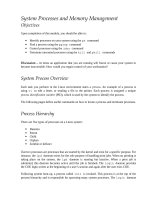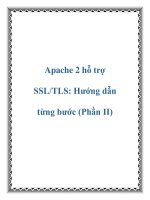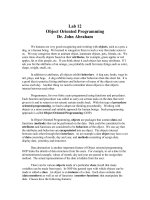CS222: Systems Programming Memory Management II pot
Bạn đang xem bản rút gọn của tài liệu. Xem và tải ngay bản đầy đủ của tài liệu tại đây (637.28 KB, 30 trang )
A Designated Center of Academic Excellence in Information Assurance Education by the National Security Agency
CS222:
Systems Programming
Memory Management II
February 21
st
, 2008
2 2/23/2008
Last Class
Memory Management
– Overview
– Heap management
– Memory-mapped files
– Dynamic link libraries
CS222 - Systems Programming
3 2/23/2008
Today’s Class
Memory Management
– Overview
– Heap management
– Memory-mapped files
– Dynamic link libraries
CS222 - Systems Programming
Heap Review
Memory reserved by HeapCreate is not
necessarily contiguous
Memory allocated by HeapAlloc is
contiguous
4CS222 - Systems Programming 2/23/2008
5 2/23/2008
GetProcessHeap
A function used for obtaining a handle to the heap of
the calling process
– Heap handle is necessary when you are allocating memory
– Each process has its own default heap, which is used by
malloc
HANDLE GetProcessHeap( VOID );
Return: The handle for the process’s heap: NULL on failure
CS222 - Systems Programming
6 2/23/2008
HeapCreate
A function used for creating a heap object that can be
used by the calling process
– Reserve space in the virtual address space of the process
– Allocate physical storage for a specified initial portion
– flOptions
• HEAP_GENERATE_EXCEPTIONS
• HEAP_NO_SERIALIZE
HANDLE HeapCreate(
DWORD flOptions,
SIZE_T dwInitialSize,
SIZE_T dwMaximumSize);
Return: The handle for the heap: NULL on failure
CS222 - Systems Programming
7 2/23/2008
HeapDestroy
A function used for destroying an entire heap
– Decommit and release all the pages of a private heap object
– Be careful not to destroy the process’s heap
Destroying a heap is a quick way to free data
structures without traversing them to delete one
element at a time
BOOL HeapDestroy( HANDLE hHeap );
CS222 - Systems Programming
8 2/23/2008
HeapAlloc
A function used for allocating a block of memory from
a heap
– dwFlags
• HEAP_GENERATE_EXCEPTIONS
• HEAP_NO_SERIALIZE
• HEAP_ZERO_MEMORY
Use HeapFree function to deallocate memory
LPVOID HeapAlloc(
HANDLE hHeap,
DWORD dwFlags,
SIZE_T dwBytes);
Return: A pointer to the allocated memory block, or NULL on failure
CS222 - Systems Programming
9 2/23/2008
HeapReAlloc
A function used for reallocating a block of memory
from a heap
LPVOID HeapReAlloc(
HANDLE hHeap,
DWORD dwFlags,
LPVOID lpMem
SIZE_T dwBytes);
Return: A pointer to the reallocated memory block, or NULL on failure
CS222 - Systems Programming
HEAP_NO_SERIALIZE
Use for small performance gain
Requirements
– No multi-threaded programming
or
– Each thread uses its own heap
or
– Program has its own mutual exclusion
mechanism
10CS222 - Systems Programming 2/23/2008
11 2/23/2008
Summary: Heap Management
The normal process for using heaps is as follows
1. Get a heap handle with either HeapCreate or
GetProcessHeap
2. Allocate blocks within the heap using HeapAlloc
3. Optionally, free some or all of the individual blocks with
HeapFree
4. Destroy the heap and close the handle with HeapDestroy
CS222 - Systems Programming
12 2/23/2008
Memory-mapped Files
Memory-mapped file functionality
– Map virtual memory space directly to normal files
Advantages
– No need to perform direct file I/O
– Data structures created in memory will be saved in the file
for later use
– In-memory algorithms can process file data even though the
file is much larger than available physical memory
– Improvement of file processing performance
– No need to manage buffers and the file data
– Multiple processes can share memory
CS222 - Systems Programming
13 2/23/2008
File Mapping Objects
As the first step to use MMF, we
– Need to create a file mapping object on an open
file
– Can give names to the object so that it can be
accessible to other processes for shared memory
– Can protect the object using security attributes
Use CreateFileMapping function
CS222 - Systems Programming
14 2/23/2008
CreateFileMapping
A function used for creating or opening a named or
unnamed file mapping object for specified file
HANDLE CreateFileMapping (
HANDLE hFile,
LPSECURITY_ATTRIBUTE lpsa,
DWORD dwProtect,
DWORD dwMaximumSizeHigh,
DWORD dwMaximumSizeLow,
LPCTSTR lpMapName
);
Return: If function succeeds, the return value is a handle.
Otherwise, the return value is NULL
CS222 - Systems Programming
15 2/23/2008
Example: CreateFileMapping
hMap = CreateFileMapping( );
if (hMap != NULL && GetLastError() == ERROR_ALREADY_EXISTS)
{
CloseHandle(hMap);
hMap = NULL;
}
return hMap;
CS222 - Systems Programming
16 2/23/2008
OpenFileMapping
A function used for opening a named file mapping
object
HANDLE OpenFileMapping (
DWORD dwDesiredAccess,
BOOL hInheritHandle,
LPCTSTR lpName
);
Return: If function succeeds, the return value is a handle.
Otherwise, the return value is NULL
CS222 - Systems Programming
17 2/23/2008
Mapping Address to Object
As the second step, we
– Need to allocate virtual memory space and
map it to a file through the mapping object
– Similar to HeapAlloc
• Much coarser – larger allocation units
Use MapViewOfFile function
CS222 - Systems Programming
18 2/23/2008
MapViewOfFile
A function used for mapping a view of a file mapping
into the address space of a calling process
LPVOID MapViewOffile (
HANDLE hFileMappingOject,
DWORD dwDisiredAccess,
DWORD dwFileOffsetHigh,
DWORD dwFileOffsetLow,
SIZE_T dwNumberOfBytesToMap
);
Return: If function succeeds, the return value is starting
address of the mapped view. Otherwise, NULL
CS222 - Systems Programming
MapViewOfFile
MapViewOfFileEx is similar
– Must specify a starting memory address
Use UnmapViewOfFile to release
memory
19CS222 - Systems Programming 2/23/2008
20 2/23/2008
Addresses Mapped to a File
CS222 - Systems Programming
21 2/23/2008
Shared Memory
CS222 - Systems Programming
FlushViewOfFile
Forces system to write changed pages
to disk
– Can be troublesome when concurrently
using regular I/O
• ReadFile
• WriteFile
– Coherency is not ensured
– Do not use these I/O functions for mapped
files
22CS222 - Systems Programming 2/23/2008
23 2/23/2008
Example: MMF-P1
#include <windows.h>
#include <stdio.h>
#define BUF_SIZE 256
TCHAR szName[]=TEXT("MyFileMappingObject");
TCHAR szMsg[]=TEXT("Message from first process");
void main(){
HANDLE hMapFile;
LPCTSTR pBuf;
hMapFile = CreateFileMapping(
INVALID_HANDLE_VALUE, // use paging file
NULL, // default security
PAGE_READWRITE, // read/write access
0, // max. object size
BUF_SIZE, // buffer size
szName); // name of mapping object
if (hMapFile == NULL || hMapFile == INVALID_HANDLE_VALUE) {
printf("Could not create file mapping object (%d).\n",
GetLastError());
return;
}
CS222 - Systems Programming
24 2/23/2008
Example: MMF-P1
pBuf = (LPTSTR) MapViewOfFile(hMapFile, // handle to map object
FILE_MAP_ALL_ACCESS, // read/write permission
0,
0,
BUF_SIZE);
if (pBuf == NULL)
{
printf("Could not map view of file (%d).\n",
GetLastError());
return;
}
CopyMemory((PVOID)pBuf, szMsg, strlen(szMsg));
getch();
UnmapViewOfFile(pBuf);
CloseHandle(hMapFile);
}
CS222 - Systems Programming
25 2/23/2008
Example: MMF-P2
#include <windows.h>
#include <stdio.h>
#include <conio.h>
#define BUF_SIZE 256
TCHAR szName[]=TEXT("MyFileMappingObject");
void main()
{
HANDLE hMapFile;
LPCTSTR pBuf;
hMapFile = OpenFileMapping(
FILE_MAP_ALL_ACCESS, // read/write access
FALSE, // do not inherit the name
szName); // name of mapping object
if (hMapFile == NULL)
{
printf("Could not open file mapping object (%d).\n",
GetLastError());
return;
}
CS222 - Systems Programming









